Growing your own avocado tree is a great option if you love the rich, creamy fruits, and they’re easier to care for than you might think.
The first step is learning about what conditions they need to thrive and produce at their best. This guide is designed to teach you just that.
Below you’ll learn all about growing avocado trees, from planting, watering, sunlight, and soil to fertilizing, pruning, harvesting, and everything in between.
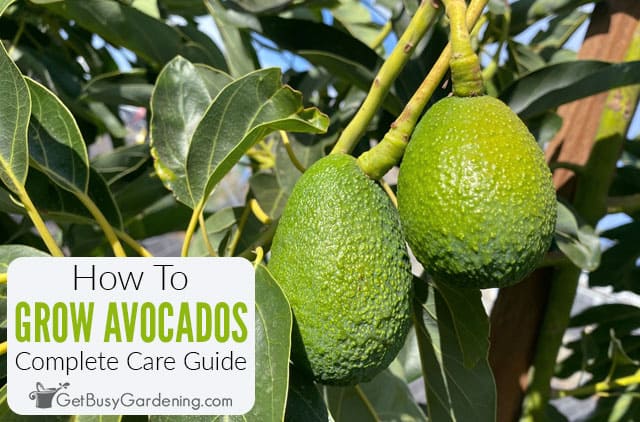
Quick Avocado Tree Care Overview
| Scientific name: | Persea americana |
| Classification: | Fruit |
| Common names: | Avocado, Alligator Pear |
| Hardiness: | Zones 8-11 |
| Temperature: | 60-85°F (15.5-29.4°C) |
| Flowers: | Yellow-green, blooms winter-early summer, depending on the variety |
| Light: | Full sun |
| Water: | Allow soil to dry between waterings, do not overwater |
| Humidity: | Average-high |
| Fertilizer: | Citrus tree slow release granules, spring after 2 years old |
| Soil: | Fertile, well-drained, loamy |
| Common pests: | Thrips, whiteflies, borers, scale, caterpillars |
Information About Avocado Trees
Avocado trees (Persea americana) are a subtropical evergreen perennial native to Mexico, Central and South America, and West India.
They can reach heights ranging between 15-60’ with a canopy that spreads up to 30’. Branches have oval green leaves up to 10” long.
Small greenish-yellow flowers grow in clusters and bloom between winter and early summer, depending on the variety.
Fruit shape and color also depend largely on the type you have. The fruits can range from light to deep green, be smooth or pebbled, and have a rounded, oblong, or pear-shape.
Different Types Of Avocados
There are 3 main ‘races’ of avocado trees: Mexican, Guatemalan, and West Indian. Mexican one are the most cold-hardy, while West Indian types are more heat tolerant.
Many popular varieties are hybrids or grafts of two races. The variety you buy affects the shape, flavor, and harvest period.
Thankfully all avocado trees can be cared for in the same way. Some of the most popular types are:
- Hass – The most consumed avocado in the US, known for creamy, high fat flesh and deep green skin when ripe. The fruits can stay on the tree for over a year, making it a great choice for a continual harvest.
- Fuerte – The second most popular US variety has very rich, creamy flesh, an easy-to-peel leathery skin, and produces oblong fruits that usually ripen late fall through spring.
- Wurtz – The only true dwarf avocado tree that stops at around 15’ tall. It produces small to medium fruit earlier than other varieties, and is a great choice for containers and small backyards.
- Pinkerton – The oblong fruit has green skin, nutty, creamy flesh, and very small pits. These avocado trees remain smaller than most and are known to be heavy producers.
- Sir Prize – This creamy large variety is ready for harvest winter-spring and is loved for its high flesh-to-pit ratio that doesn’t brown when cut.
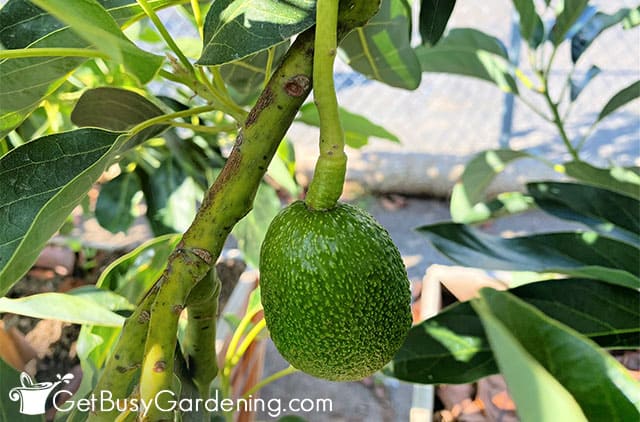
Hardiness
Avocado tree hardiness depends on the variety, but they’re typically not tolerant of cold temperatures. Most grow year round only in zones 10-11 and will not survive 32°F (0°C) or lower. But some are hardy down to zone 8.
In cooler climates with only mild frosts, you can protect the roots with mulch and cover the leaves with blankets. Otherwise you must grow them in a container that can be moved inside.
How Do Avocados Grow?
Avocados grow from flowers that are pollinated by insects like bees, but it can be tricky with only one tree.
The flowers have both male and female anatomy and can technically self-pollinate. But the blossoms open as either male or female, and never at the same time.
The pattern of the flowers determines if the tree is Type A or Type B. Type A opens as females during the morning, then closes and reopens as males the following day. Type B is the opposite, opening first as males then as females second.
Having one of each allows for much easier pollination and increases fruit production significantly.
Hass, Wurtz, and Pinkerton are popular Type A avocado trees, while Fuerte and Sir Prize are Type B.
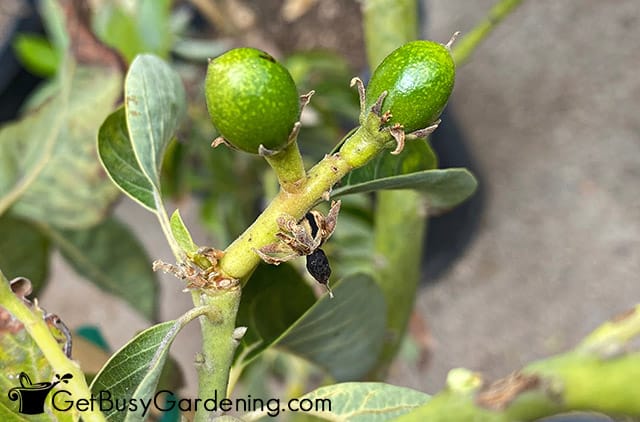
How To Grow An Avocado Tree
Before we talk about proper care, first we should chat about where and when to plant your avocado tree. The right location and timing are the first steps for a happy, healthy tree.
Where To Grow An Avocado Tree
Avocado trees can be grown indoors, outdoors, and even in large containers that have proper drainage. To reach their maximum size and fruit potential, planting them in the ground is best.
They need full sun, loose fertile soil, protection from the wind, and plenty of space without obstructions. Don’t place them too near the house, power lines, or other trees.
Make sure the soil is loose, not compacted, and rich with nutrients. Then dig a hole that’s at least 2-3 times the size of the rootball.
Young trees have delicate roots that need to be handled carefully during planting.
When To Plant An Avocado Tree
The best time to plant an avocado tree is in the late winter or early spring when the weather is cool.
That allows young trees to acclimate to the soil and environment before the summer heat, which can cause damage and dehydration of very young new transplants.
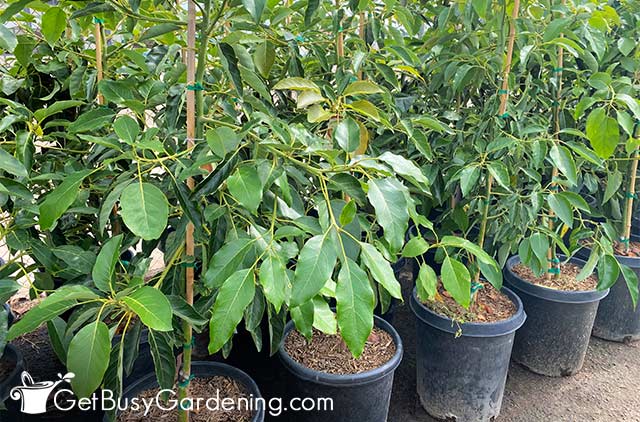
Avocado Tree Care & Growing Instructions
Now that you know where and when to plant, it’s time to get into how to care for an avocado tree as it grows. They’re low-maintenance and hassle free once you understand what they need.
Sunlight
Avocado trees need full sun for at least 6 hours a day. Too much shade will slow their growth and prevent or lessen flowering and fruiting.
Choose a spot that will allow the canopy to spread without being shaded by obstructions like other trees or structures.
Water
Persea americana is sensitive to overwatering and root rot, but is not drought tolerant. They do best with deep, thorough watering after the soil has dried out slightly.
Don’t overwater to the point of making the soil wet or soggy. Usually 2 inches once a week is adequate, or up to twice a week in hot weather.
Mulches, like wood chips, are a great way to retain the soil moisture, but always leave a few inches of space between the trunk and mulch to avoid issues of rot.
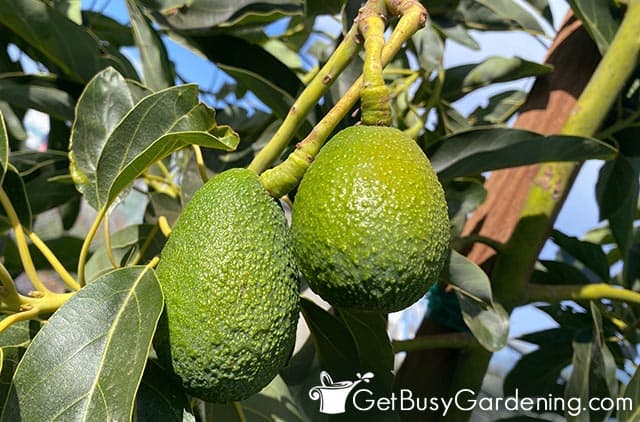
Temperature
The ideal temperature range for an avocado tree is between 60-85°F (15.5-29.4°C). They are not cold hardy or tolerant of very high heat.
When it drops to below 40°F (4.4°C) they can begin to suffer leaf drop and damage. Extended cold weather or temps below 32°F will eventually kill them, and hardier varieties will lose their leaves.
Highs of 100°F (37.7°C) or more will lead to a less productive plant, dehydration, and sun damage, especially in arid climates.
Fertilizer
Avocado trees are not heavy feeders, but the occasional addition of fertilizer can help boost growth and fruiting.
Avoid all fertilizer for the first year after planting. The roots are sensitive during that time, and the salts and minerals in fertilizer can easily burn them.
During the second year you can begin applying a citrus tree slow release granule, or an organic fertilizer with zinc and high N and P values.
Work it gently into the soil annually during the spring. Once the tree is mature enough to fruit, switch to an option with high N and K values.
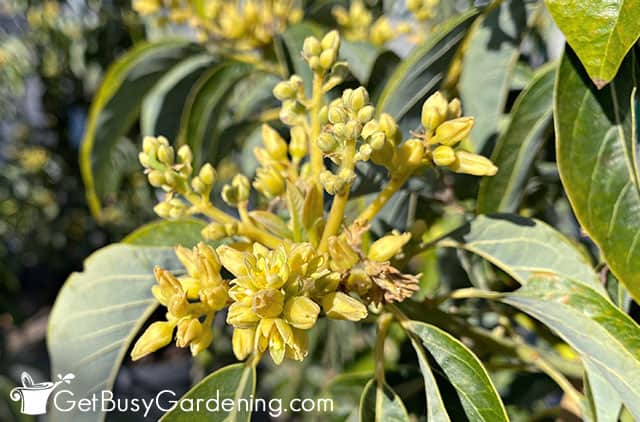
Soil
Avocado trees aren’t very picky about soil type or pH, but they’ll do best in a well-drained loamy or sandy mix that’s rich in organic matter.
They will not grow well in heavy clay based soils however. Amend those with sand or plenty of compost to improve drainage and prevent issues of root rot.
Pruning
It’s not necessary to prune your avocado tree frequently as part of their regular care. But the occasional trim will control the size and spread so you can reach the fruit easier.
It’s best to trim them before fruiting begins, often in later winter or early spring. Remove dead wood with a sharp, sterile pair of hand pruners for small branches, or loppers for larger ones.
To reduce the height, find the tallest branch and cut it back to below the first set of leaves. That will encourage bushier, outward growth instead.
Pest Control Tips
Avocado trees are susceptible to pests like thrips, whiteflies, scale, caterpillars, and borers.
You can treat small insects with neem oil or an insecticidal soap. I make my own by combining 1 teaspoon of gentle liquid soap with 1 liter of water.
Hand-pick larger insects and drop them in a bucket of soapy water. Borers can be very difficult to control, so look for holes in the branches and prune away any affected limbs.
Disease Control Tips
Persea americana is susceptible to fungal diseases like root and fruit rot, and some viruses like sunblotch. These usually cause damaged foliage, misshapen fruit, and reduced yields.
Using an organic fungicide in the early stages can help to slow or even stop the spread.
The best way to prevent these issues is to avoid overwatering, buy disease free and resistant trees, and keep your yard clean of debris.
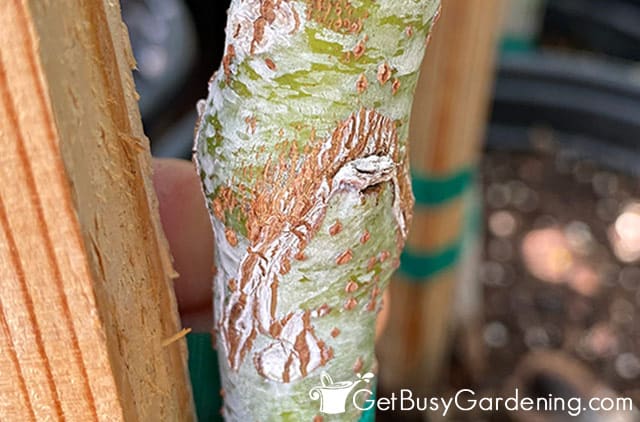
Tips For Harvesting Avocados
Avocados can be tricky to harvest for beginners because they do not ripen on the tree, and often do not change color.
The time of year is also dependent on the type you grow. Check your specific varieties’ typical harvest season. Then pay attention to the fruit size.
When the fruits reach the ideal mature size, pick one and leave it on the counter. If it softens and ripens in 1-2 weeks, you can continue to harvest. If they shrivel and shrink, they’re not ready.
Use a sharp pair of pruners to cut the fruits off where the stem attaches to the branch. Don’t pull them or you may cause damage instead.
You can leave the fruits on the tree for a while, and they will continue to get richer in flavor. But don’t leave them for too long, they will eventually become rancid and fall off.
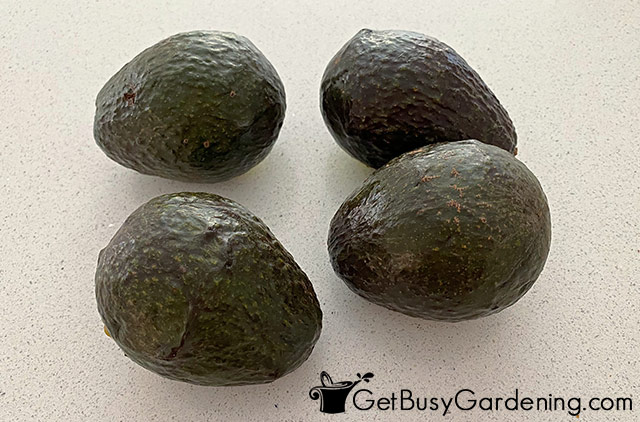
Troubleshooting Common Problems
In a good environment avocado trees are simple to care for, but no plant is problem free. If you experience one of these more common issues, my tips will help you get yours back into healthy shape.
Brown Leaves
Brown leaves on an avocado tree can be caused by underwatering, low humidity, frost, fungal diseases, or fertilizer burns.
The soil should dry between drinks, but never be bone dry for extended periods of time.
Treat diseases with an organic fungicide, and reduce the spread by keeping the area around the trunk clean of debris.
Too much synthetic fertilizer can easily burn the roots from the salt, especially on young trees. Instead, use an organic brand and apply it annually beginning the second year.
No Fruits
The most common causes for no fruits on an avocado tree are age, lack of pollination, and temperature extremes.
It takes grafted trees at least 3 years to be mature enough to produce fruit. Avocado trees grown from seed can take 10 or more.
Once mature, the flowers must be fertilized to fruit, and that can be tricky with a single tree because the male and female flowers do not open at the same time.
Increase your odds by having two trees, one type A and one type B, and growing them in temperatures that don’t exceed 85°F (29.4°C) or fall below 60°F (15.5°C).
Yellow Leaves
Yellowing leaves are caused by overwatering, pests, and lack of sunlight. Let the soil dry between deep, thorough waterings and avoid puddling the soil.
Keep them in full sun for 6 hours a day and watch for signs of pests, like leaf and branch damage. Treat any bugs you find immediately.
If just the occasional few leaves are yellowing and the tree is putting on new growth, it’s normal and nothing to be concerned about. Once the leaves are completely yellow, you can just remove them.
Leaves Dropping
Dropping leaves are caused by frost, wind, root rot, and inconsistent watering. Avocado trees need protection from wind and temperatures below 40°F (4.4°C).
They’re highly susceptible to root rot, so avoid overwatering. Give them deep, slow drinks once a week, or twice in warm weather, and avoid letting them go from one extreme of very wet to very dry.

FAQs
Here I’ve answered some of the most commonly asked questions about avocado tree care. If yours isn’t listed, please add it to the comments section below.
How long does it take for an avocado tree to bear fruit?
It can take anywhere from 3-5 years for an avocado tree to bear fruit. If you’re attempting to grow it from a pit, expect to wait closer to 10+ years.
Are avocado trees hard to maintain?
No, avocado trees aren’t hard to maintain. They require minimal pruning and fertilizer, and are happy to grow in most soils with adequate water, sun, and the proper temperature range.
Do you need 2 avocado trees to produce fruit?
You do not technically need 2 avocado trees to produce fruit since they all contain both male and female flowers. However having one type A and one type B will increase the likelihood of pollination and improve the fruit production of both trees.
Where do avocado trees grow best?
Avocado trees grow best in mild climates that don’t experience cool or hot temperature extremes, like zones 10-11, but some can survive down to zone 8. They like loamy, fertile soil, warm weather, consistent water, and plentiful sun.
Do avocado plants like sun or shade?
Avocado plants like sun and need at least 6 hours of full exposure every day to grow and produce at their best.
If you’d like to learn how to make the most of your space and get as much homegrown food as possible, then my Vertical Vegetables book is perfect! It will teach you all you need to know, has tons of gorgeous photos, and includes 23 DIY projects you can build for your own garden. Order your copy today!
Learn more about my Vertical Vegetables book here.
More About Vegetable Gardening
Share your avocado tree care tips in the comments section below.
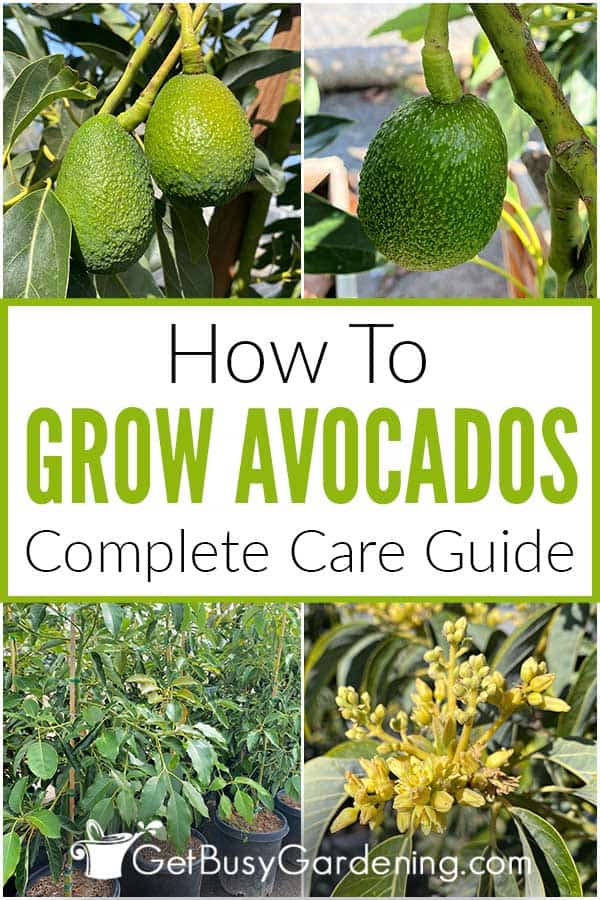
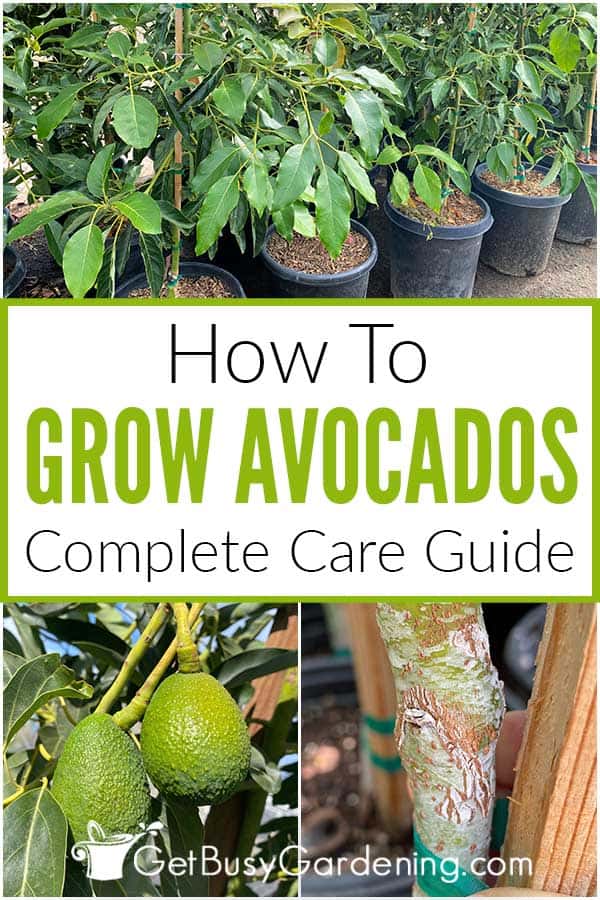





Michelle R. Scott says
If I had a grow light, could I grow them in my basement in a large pot? I live in Pennsylvania, so not a good place to grow them. But was wondering if I could in an artificial environment.
Amy Andrychowicz says
Yes, they make great houseplants. It probably won’t set fruit indoors though.
Thanasis Soultatis says
You say zones 8-11 but they don’t tolerate 32F? Then they should be zones 10-11.
Amy Andrychowicz says
Sorry for the confusion. Most avocado trees are only hardy down to zone 10. But there are a few hybrids that can survive freezing temps down to zone 8. I updated the text to make that move clear, thanks for pointing it out. 🙂